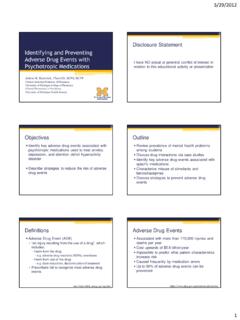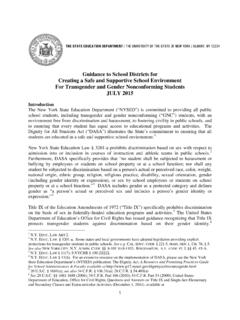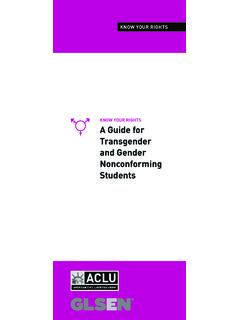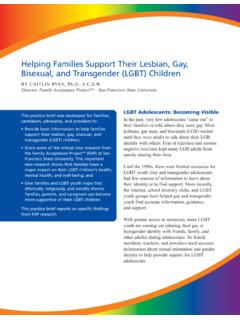Transcription of FALL 2021
1 A C H A N C H A III. II. American College Health Association National College Health Assessment FALL 2021. Reference Group Executive Summary Table of Contents I. Introduction and Notes 1. II. Findings A. General Health and Campus Climate 3. B. Nutrition, BMI, Physical Activity, and Food Security 3. C. Health Care Utilization 4. D. Impediments to Academic Performance 5. E. Violence, Abusive Relationships, and Personal Safety 7. F. Tobacco, Alcohol, and Other Drug Use 8. G. Sexual Behavior 11. H. Mental Health and Wellbeing 12. I. Acute Conditions 14. J. Ongoing or Chronic Conditions 15. K. Sleep 17. III. Demographics and Sample Characteristics 18. ACHA, the nation's principal advocate and leadership organization for college and university health, represents a diverse membership that provides and supports the delivery of health care and prevention and wellness services for the nation's 20 million college students .
2 For more information about the association's programs and services, visit , and Suggested citation for this document: American College Health Association. American College Health Association-National College Health Assessment III: Reference Group Executive Summary Fall 2021. Silver Spring, MD: American College Health Association; 2022. Introduction and Notes The ACHA-National College Health Assessment (ACHA-NCHA) is a national research survey organized by the American College Health Association (ACHA) to assist college health service providers, health educators, counselors, and administrators in collecting data about their students ' habits and behaviors on the most prevalent health topics. The ACHA-NCHA now provides the largest known comprehensive data set on the health of college students , providing the college health and higher education fields with a vast spectrum of information on student health.
3 ACHA initiated the original ACHA-NCHA in 2000 and the instrument was used nationwide through the Spring 2008 data collection period. A revised survey, the ACHA-NCHA-II, was in use from Fall 2008 - Spring 2019 data collection periods. The survey was redesigned again, and data collection with the ACHA-NCHA III began in Fall 2019. Please note that it is not appropriate to compare trends between versions of the survey. Directly comparing data points between the Original ACHA-NCHA, the ACHA-NCHA II, and the ACHA-NCHA III can lead to an erroneous conclusion and is not recommended. Notes about this report: 1. Missing values have been excluded from analysis and only valid percents are included in this document, unless otherwise noted.
4 2. The ACHA-NCHA III is programmed differently than earlier versions of the survey. Rather than asking the respondents to answer every question (and offering a "not applicable" option), display logic was used throughout the survey to determine whether, based on their response to an earlier question, the student saw a follow-up question. This makes the valid percents of certain questions impossible to apply to the entire sample, as the denominator used was limited to only the number of students that saw the question. When appropriate, results are also presented using the entire sample as the denominator to show the proportion of the overall sample that experienced a particular issue. These differences in presentation are carefully noted throughout the document and will often explain differences observed between this document and the full data report.
5 Please look carefully at descriptions of the data presented in each table, as well as any footnotes included. 3. About the use of sex and gender in this report: Survey results are reported by sex based on the responses to questions 67A, 67B, and 67C. The responses to these questions are used to create a new variable called RSEX. RSEX is used for organizing results in the ACHA-NCHA report documents. Respondents are reported as cis men or cis women only when their responses to 67A, 67B, and 67C are consistent with one another. If gender identity is consistent with sex at birth AND "no" is selected for transgender , then respondents are designated as either cis men or cis women in RSEX. If respondents select "yes" for transgender OR their sex at birth is not consistent with their gender identity, then they are designated as transgender /gender non-conforming in RSEX.
6 A respondent that selects "intersex" for sex at birth, "no" for transgender , and man or woman for gender identity are designated as cis men or cis women in RSEX. A respondent that selects "intersex" for sex at birth, "yes" for transgender , or selects a gender identity other than man or woman are designated as transgender /gender non-conforming in RSEX. A respondent that selects another identity on 67C is designated missing in RSEX. A. respondent that skips any of the three questions is designated as missing in RSEX. Totals displayed in this report include missing responses. Please see the ACHA-NCHA III survey codebook for more information about how data on sex and gender are coded. For additional information about the survey's development, design, and methodology, email Mary T Hoban, PhD, MCHES, Christine Kukich, MS or visit 1.
7 We need to draw your attention to an important change in your ACHA NCHA Report documents. Beginning in Spring 2021, responses for transgender and gender nonconforming students are readily available directly in the report documents. This represents an important change in the way we have been reporting ACHA NCHA results. We've prepared the following information to better explain the specific changes, our reasoning for doing so, and tips for using these redesigned report documents. I. What we've done to date The ACHA NCHA has asked respondents about their gender identity for 12 years. Data on transgender and gender nonconforming (TGNC) students was available in the data file, but not displayed explicitly in the report documents documents in an effort to protect the privacy of TGNC students , particularly those students in smaller campus environments and at schools that publicly shared their ACHA NCHA report documents.
8 We have been trying to find the right balance between protecting students ' privacy and making the results accessible to campus surveyors who may not use the statistical software that would be required to extract this information directly from the data files. Until now, we've erred on the side of protecting student privacy. II. Why change? The number of TGNC students in our samples has been increasing over the years. Between 2008 and 2015, the number of students identifying as TGNC was very small (less than ). We've learned over the years that gender identity is complex and fluid. To better capture this complexity, we began asking separate questions about sex at birth and gender identity in Fall 2015.
9 Now TGNC students tend to represent 3 4% of the overall sample. With greater number of students identifying as TGNC on the ACHA NCHA in recent years, we have a better opportunity to understand their needs and behaviors than we have in years past. A number of health disparities between TGNC students and their cisgender peers have been well documented[1], and schools need readily available access to this data in order to better address the needs of TGNC students . III. What's different about the way we are reporting? First a note about how we have been reporting ACHA NCHA results to date. RSEX is a variable we create based on the responses to the questions on sex at birth, whether or not a student identifies as transgender , and their gender identity.
10 The RSEX variable had allowed us to sort respondents into 4 groups for reporting purposes: male, female, non binary, and missing. (Details about this variable can be found in all report documents.). The value labels for RSEX have been revised to better represent gender identity rather than sex. A value of 1 has been changed from Male to Cis Men[2]. A 2 has been changed from Female to Cis Women[3]. The value 3 has been changed from non binary to transgender and Gender Nonconforming (TGNC), as it's a more accurate and inclusive term. The value 4 on RSEX remains missing/unknown and is used for students who do not answer all three questions. The missing/unknown column in the Data Report document has been replaced with a Trans/Gender Nonconforming column.
















